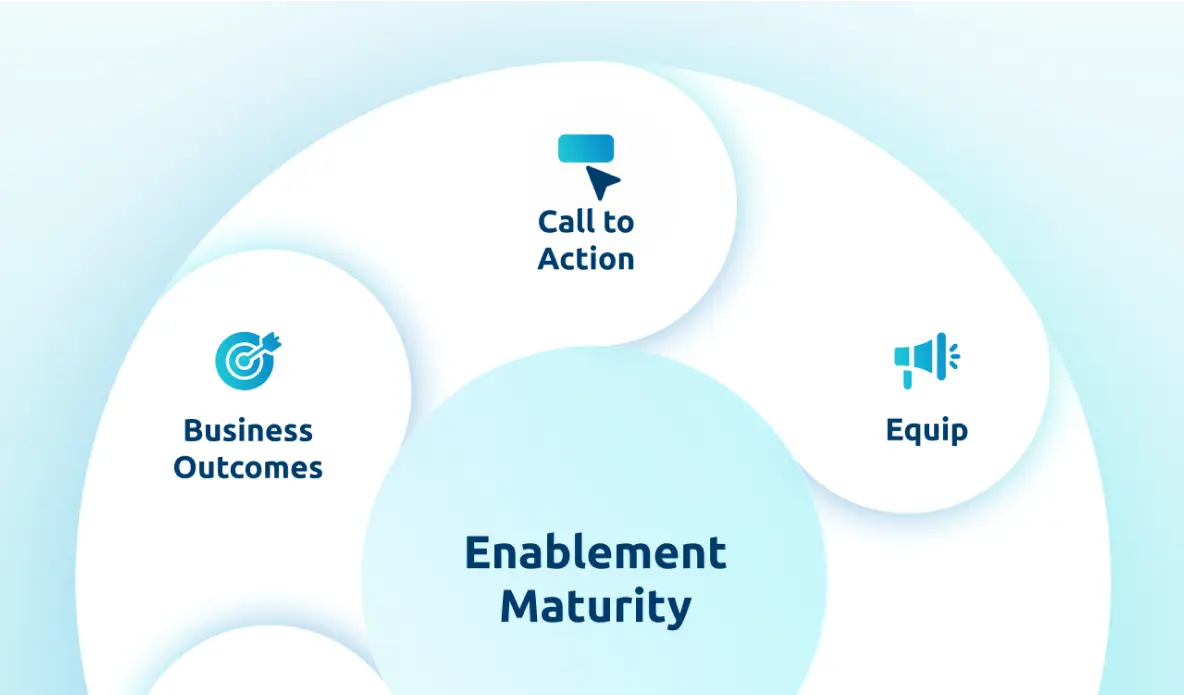In our recent research study, 100% of sales leaders agreed that you need both an effective tool and strategy to succeed in enablement. So, how can you maximize the impact of enablement at your organization with an effective platform and strategy?
Shawnna Sumaoang: Hi and welcome to the Win Win Podcast. I’m your host, Shawnna Sumaoang. Join us as we dive into changing trends in the workplace and how to navigate them successfully. Here to discuss this topic is Dustin Day, senior manager of global sales enablement at Coursera. Thanks for joining, Dustin! I’d love for you to tell us about yourself, your background, and your role.
Dustin Day: Thank you, Shawnna. My name is Dustin and I am on the Coursera Global Sales Enablement team. I’ve been with Coursera for a little bit over a year now focusing on everything from manager enablement, product enablement, go-to-market motions, and supporting the Highspot initiative and how we position it, and how we grow it with the team.
My background, I grew up in a company called CEB, which is now called Gartner, focusing on L&D research, which is really where I started to get my sales support background. I went into education publishing, now branded EdTech today, and focused on the finance and strategy aspect of sales. Then I went to an organization named Challenger, which is where I worked with global companies supporting their sales leadership, and sales enablement team around the challenge of sales methodology.
That’s where I got interested in more of the perspective of sales enablement and becoming more of the practitioner as opposed to the thought leadership kind of execution side of sales methodology. I am happy to be here, Shawnna, and looking forward to our conversation.
SS: I’m excited to have you here as well, Dustin, and it sounds like you have a phenomenal background to answer our first question, which I’d love to start with. What does good enablement look like in your opinion? In other words, what are some of the key components of an effective enablement strategy?
DD: I think this is the big question in the industry today and I think it’s one that individuals like myself, do not struggle with, but are constantly trying to reimagine. Historically, if you looked at sales enablement, it grew out of a pure sales L&D motion, pure training, getting in front of the field, and training them on the skills that are necessary for them to succeed.
That’s still a huge component of sales enablement, but being at the center of how you support the team and the growing nature of sales, we have started to see sales enablement grow into looking at the sales cycle and trying to find efficiencies within our sales cycle, the buying process and trying to identify the buying process and build those play cards to support the field and how they engage with and the customer journey.
As sales enablement evolves, I think there still needs to be that mix of formal sales training or skill-building exercises if you want a position like that, but also how do we get the field to be equipped for the future? This virtual environment has changed the nature of sales, changed the nature of the buyer, and organizations like ours and our sales force are constantly learning how to navigate that as the buyer has gotten smarter and started to evolve faster than we’ve been able to evolve from a commercial engine perspective.
SS: I love that. We talked a little bit about when you joined Coursera, but I know it was right at the start of the team’s partnership with Highspot. Tell us a little bit about the enablement journey that Coursera has been on since you implemented Highspot, and how has your enablement strategy evolved from then until now?
DD: In the original use case for Highspot, we were hosting all of our materials on a central intranet site, and that naturally created a ton of pain points in terms of finding content, engaging with content, and proactively providing feedback for us to keep things fresh. There were a lot of inefficiencies built in just the pure commercial support engine.
As we looked at Highspot, the original use case was let’s get our content onto Highspot, get it organized in a way that at least helps the team build and have those resources and the collateral available to them today. That was stage one. I think stage two has essentially defined our sales enablement strategy more broadly, which is that we created additional pain points by just uploading resources. We started to say, how do we organize, create that feedback loop and essentially help our marketing team skip a lot of steps in their process as it relates to building content and getting content onto the platform?
As we developed that strategy and started to do the change management with marketing and the sales team, getting more content collateral in front of them, they created an additional pain point, which was governance. Our strategy and our problems have grown in a good way. We’ve created pain points that we needed to solve, but that is good because we are not doing what we originally did today.
What we did in Q2, our team essentially built a content governance strategy that we now maintain on a quarterly basis where we archive pieces of content based on the criteria that are really important to us as it relates to content freshness. We start to track those KPIs and report on those KPIs as part of showing the value in sales enablement. We’ve started to build this governance structure to make sure that that content support engine is running on all cylinders.
Our marketing team understands utilization and we’re continuing to grow that as we start to build out our Q4 and our next year strategy, which is sales play specifics. Organizing everything in one central spot so nobody has to go find things and search for things in random areas, but also as we build those sales plays focusing on getting stronger at, it’s probably the best way to say it, our customer personas. Also, the outreach Salesforce reports that we can put into one place custom-built for the AE. The What to Know section has everything that you need to know about content. We are a content company. Anytime we work with a customer, there’s a lot of moving pieces in our product.
Then also what to show, so clearly breaking down that sales process aspect and making sure that the team can see before the meeting, during the meeting, and after the meeting, or if not leadership, here are the things I should be bringing to our customer. That’s how our strategy has evolved. Our KPIs have moved with it, and our pain points have evolved in a good way as well and we’ve kind of continued to evolve the strategy.
SS: I love that. It does sound like you guys are moving up that maturity curve. Fantastic work there. I definitely want to come back and revisit the work that you guys are doing on Plays in just a little bit, but to help context that too for the audience, what were some of the key business challenges that Highspot helped solve at Coursera?
DD: First it’s just content. We have a very large marketing team at Coursera and if you’re familiar with the Coursera go-to-market, or who we are, we have a very large consumer B2C revenue stream. It’s where most of our revenue comes from. We have a lot of B2C marketers that create a lot of B2C kind of content and collateral.
As we started to clean things up, some of the original pain points were how do we get ourselves organized, get some of that more B2B content front and center, remove the noise from a content perspective from the peripherals, and get the team focused. That was the original pain point. It was a pure play of we are unorganized from a content organization perspective. We need to put some rigor behind it as we mature as a business.
We did that. I think we’re a year and a half in at this point. As we continue to build that muscle, we feel like we’re growing in our maturity and the problems and the KPIs have started to grow with that.
SS: How has Highspot helped you solve some of those challenges?
DD: Well, first of all, we love to organize our content. We haven’t been able to organize it effectively to date, and so we are able to do two things. One was tagging our content to make it easier for the rep to navigate Highspot quickly. While it is a great platform for us in sales enablement and our colleagues in marketing, we really don’t want our field spending 20 to 30 minutes anytime they’re in the system to find what they need.
The tagging and getting the content front and center have been super helpful for us to measure the utilization of our content as well. We have so much like what are people using, why they use it, and how we can be smarter in creating or building off of content that has been wildly successful as opposed to just putting it there and letting it sit underutilized.
So that’s one use case. The other use case, which we’ll talk about a little bit is from a sales play organization. We’re also about to pilot our first newsletter launch here this week. From an enterprise perspective, we’re going to be consolidating all of the communication channels using the Highspot functionality to kind of pitch it out to the team. We’re going to start to look at utilization, start to look at click-through rates, and start to use the tool almost like a selling tool internally to engage with the field and start to measure how we can better support the field.
SS: I love that. Actually, recently your team also expanded to use Highspot to include Training and Coaching capabilities. What was the impetus for making the change to invest in a unified enablement platform?
DD: Originally we were using Lessonly. That originally started with onboarding as part of our onboarding learning paths. We were having new hires go into Lessonly and then be pushed to content and support materials on Highspot. It just felt kind of like a weird user experience. As we started to assess that, the Highspot account management team started to talk to us about the learning platform component, we made a decision to have that consolidated platform where at the end of the day, simply said, it is one place versus many places.
I think particularly in sales enablement, there are a ton of new platforms and products and support tools out there. I’ve even seen Slack starting to get into certain things. Microsoft Teams has a content organization aspect to it. For us, it really simplified the one-stop shop for our team to go to as it relates to their learning paths, as it relates to new go-to-market builds, as when we went to upskill, reskill the team we’ve been able to use some of the recording functionality, have managers listen and sign off, build best practice pages around what a good pitch looks like and start to flex that muscle a little bit better than we had in the past.
It also aligns with our content. We can easily say, this is content number one. There’s a great best practice pitch from a recent training and we can link to that as well. It’s really helped solve a lot of those really minor but tedious steps that our field would have to take prior to getting anything done or just to navigate any type of system we have.
SS: I love that you guys are taking that unified approach, though, because it makes it a lot more seamless for your reps, and obviously we want to be where your reps are to make them more productive. Another way that you’re thinking about it from a unified platform perspective and you’ve touched on this a little bit, so I’d love to drill in, is that big initiative around the sales plays aligned to training. Can you tell us about this initiative and why it’s a focus for your team?
DD: Historically we have built Highspot pages essentially in a silo, which is here’s the one-stop shop for just all pieces of collateral as it relates to an academy for example. We got feedback that, oh, how do I navigate it? Where do I go? What we did is we’ve taken the structure that Highspot provides, which is what to know, say, and show, and we’ve taken that and really run with it. We organize every one of our sales plays now around a very specific product suite.
We start with what to know, which is typically something around the customer persona, or we may separate it out, depending on who the customer persona is. The customer persona is a deeper dive from a Coursera perspective into the content, and the demo environments that we have related to that. Then we go into what to say, which is much more of that, that go-to-market narrative, objections, key talking points, use cases, for example, that we can speak to.
Then what to say, and that’s actually helped our team really at the end of the day, organize their thoughts and know how to quickly navigate. Another output of that is now we organize our field training around that exact same structure. It’s given us a new structure to engage with the field from a live virtual training perspective when we’re talking about more of our go-to-market motions as opposed to skill-based motions.
From a product go-to-market motion, we bring up the sales play and we work through the sales play as the structure of our field training. That’s also been helpful. Sales play will continue to evolve and we’ll continue to build on it, but it’s laser-focused on, it’s got us, from a go-to-market perspective, much more deliberate than I think we had been doing in the past.
I think that’s been an incredible output, and one that we’re starting to see the field feedback be, this is great, and the questions are more focused on very specific product nuances and or talk tracks as opposed to where is this hosted. How do we navigate this? It’s much less technical highspot questions and more of what we hope they’re asking questions about.
SS: I love that. You guys are already seeing some amazing results. I mean, you guys have driven a 77 percent increase in play adoption. How did you effectively launch this initiative to your sales teams? And maybe what are some of the results that you’ve seen so far?
DD: We piloted it with a launch probably back in July or August 2023. As part of that, it was a new motion and it required change management. We used to just, for our Tier 2 and Tier 3 launches, we used to just go through Slack and or email channels to get the communication out, link to the Highspot main page for our vertical, and then say, here are the links that you need to be effective.
What we did is we launched training that was designed, yes, to equip the field but also an introduction to the Highspot page itself. Now it’s just pure behavior change motions. Now we bring it up constantly for any new sales play launch. We break it down in our communications. Here’s your know, say, show. In any training, we’ve been following up with training more than we have in the past to help kind of reinforce that know, say, show. It’s just kind of hammering the nail over and over and over again in a productive way for the field.
From our perspective, we’re also driving that behavior change by making it front and center as this is the way we’re going to operate. A Little carrot and stick approach, but from our perspective, it was a behavior change play and part of that behavior change is getting people bought in that this is how we’re going to operate first and foremost, and then hopefully they see the value and they see the benefits that they get out of it.
SS: Now you guys have also just seen some incredible traction with Highspot overall. I think you guys have 85 percent recurring usage. What are some of your best practices for driving adoption and how has having a unified platform helped?
DD: This may pain some sales enablement practitioners but early on, we used Google Suite for Gmail and Docs and Sheets, and every time an announcement would go out, that colleague would share a Google Doc. This is the link to the Google Doc, and in the title, it would say, make a copy. You have this plethora of random copies out there to the team.
One of the things that we do constantly day in and day out to anybody that we ever see send communications is if they don’t share the Highspot link to the resource, we always literally will follow up and say, hey, recommend that you share the Highspot link instead. Here’s the reason why. We can track if people are using it, seeing it, clicking on it, et cetera. We just have to get the links for Highspot out there as the single source of truth.
The other bit is from a recurring use perspective, we have started to leverage Highspot for more of our knowledge management side of the aisle. This is definitely a work in progress and we’re continuing to think about and trying to understand the use cases, but we’re building playbooks for our roles. As part of building playbooks for our roles, we’re going to host that playbook on Highspot in a knowledge management center. Again, with links out into the different resources that are on Highspot to help these roles execute.
It’s identified areas that we don’t have very tangible support in now. It helps us prioritize what we need to build and when we build those, we build them in Highspot. Reoccurring uses actually are more of a muscle that we need to have from a sales enablement perspective as opposed to the field. If everything is in there organized and it’s the single source of truth, as you mentioned, the unified platform, if that’s the case, they have really no choice but to go in to get the information, to get the details, to get the content that they need.
SS: I love that philosophy and I love that you guys are driving that to change the behavior of your field teams. Now, you have a lot of big plans for evolving Highspot going forward. Can you tell us more about your vision for continuing to evolve your enablement and how you plan to leverage Highspot to help?
DD: There are four key initiatives that we’re continuing to think about for some and explore for others in 2024. The first one at the forefront is the constant governance muscle. We do quarterly governance, like sprints we’re calling them, where we identify the content that hasn’t met the criteria for freshness. We get that content in front of our product marketing and customer marketing teams for them to vet if it needs to be there. Then an archiving sprint in the latter half of the quarter and measure in the following quarter. Constantly building in that muscle. That’s a priority at the end of the day that we cannot forget about, but we can’t deprioritize as we do everything else.
The other three things I mentioned briefly, which is getting smarter about our sales plays. How do we continue to build those and make them more effective on a yearly basis? As we’re looking at our yearly strategy, what are those sales plays, those go-to-market priorities that we have to hit on, and how can we build out a sales place for that?
It’s giving us more face time to be candid with senior sales leaders, and sales executives to include us in those conversations because they know to execute on that, they’re going to need our team’s support around the sales plays. Candidly there’s like a quid pro quo in that approach and that’s good.
The third piece is the knowledge management aspect of it. Building that knowledge management base, that’s going to be a big priority. We’re still learning and adapting to that. The fourth piece, which we haven’t explored yet, but I know Highspot has a lot of great research around, is salerooms. That single source of truth, where you can see how the customer interacts with the content, what they’re clicking on, it’s more customer-facing.
There’s a huge opportunity for us to have that more customer-facing digital rooms approach. How can we build that into our motions today? I think we have to get the sales play right, and we have to get the governance right, so people can trust the content, they can trust the source of the content. The digital rooms are kind of the next step in our maturity to ensure that we can get analytics and real-time feedback from customer engagement.
SS: Absolutely. I have to say I love the evolution of digital sales rooms and the visibility it gives you into what is really resonating with your buyer at the end of the day. I really appreciate all of the time, Dustin. Thank you so much for joining us today.
DD: Thank you.
SS: To our audience, thank you for listening to this episode of the Win Win Podcast. Be sure to tune in next time for more insights on how you can maximize enablement success with Highspot.




